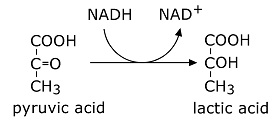|
Fermentation
Fermentation is the use of some molecule other than oxygen as the final electron acceptor during breakdown metabolism (catabolism). In the breakdown of glucose (glycolysis) there is a high energy hydrogen picked up by NAD to form NADH. The electron pair that goes with that hydrogen is high in energy. Something needs to be done with it. It could be used through respiration to yield three ATPs. But sometimes respiration is not possible, either because the system does not exist for the organism, or because oxygen is lacking. Under these conditions the hydrogen is dumped onto another molecule and excreted. The excreted molecule is sometimes ethyl alcohol, and the result is then called alcoholic fermentation. Alcoholic Fermentation:
Glycolysis breaks glucose down to pyruvic acid. Fermentation then removes the carboxyl group from pyruvic acid causing carbon dioxide gas to be excreted. The NADH then dumps its hydrogen onto the 2 carbon molecule creating ethyl alcohol. Lactic Acid Fermentation:
In some cases lactic acid is the excreted product of fermentation. Then there is no carbon dioxide gas excreted. This type of fermentation is produced by muscle cells when they lack sufficient oxygen.
|

